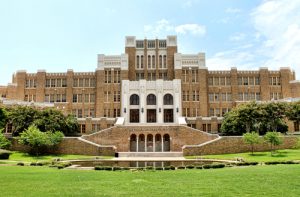
An effort led by U.S. Rep. French Hill (R-AR) to expand the Little Rock Central High School National Historic Site to include nearby homes that were involved in school desegregation efforts there gained House approval on Tuesday.
The Little Rock Central High School National Historic Site Boundary Modification Act, H.R. 2611, would expand the historic site by 1.47 acres to include seven nearby homes where the “Little Rock Nine” group of African-American students met to walk to school each day.
Hill thanked U.S. Reps. Rob Bishop (R-UT), the chairman of the House Natural Resources Committee, and John Lewis (D-GA), a pioneer of the civil rights movement, for their work in advancing the measure.
“Just ahead of the historic 60th anniversary, we’re commemorating the Little Rock Nine and their brave role in the fight for equality,” Hill said. “As we celebrate, this legislation that passed the House today ensures the proper historical inclusion of the seven homes located across South Park Street from Little Rock Central High School. Together with the school, they will now stand as living monuments to the civil rights movement in Arkansas and the United States.”
Little Rock Central High School became the national symbol for the struggle over desegregation after the Supreme Court ruled in 1954 that segregation of public schools was illegal.
“Preserving the streetscape as close to what it was in 1957 serves as a historic reminder for all modern-day history travelers retracing the steps of the civil rights movement,” Hill added.
Lewis recalled that he was 17 years old when Little Rock Central High School was desegregated in 1957. The Little Rock Nine, he added, encouraged young people across the country to “to stand up, to speak up and to speak out.”
“Central High is part of our history that must be preserved for a generation yet unborn,” Lewis said in remarks on the House floor.
He recalled how he visited the school a few years ago and was escorted through the halls by an African-American student who was president of the student body. “I felt like I was walking in a special place, almost a holy place. It brought tears to my eyes. During those dark and difficult times, the national historic site became a beacon of hope, an inspiration that we can never give up, that we can never give in as we strive towards equal rights and justice for all.”
In addition to expanding the historic site’s boundaries, H.R. 2611 would authorize the interior secretary to pursue cooperative agreements with the owners of the seven homes to provide technical assistance for the preservation, restoration and labeling of the historic properties.
“This is significant, and I cannot think of this story without in some way feeling choked up inside because I know what it must have been like for those kids to go there, and I know what it must have been like to be part of that milieu,” Bishop said on the House floor. “This was historic. They were true heroes. They were truly brave kids who took this event on and did it with such aplomb. They need to be remembered.”



